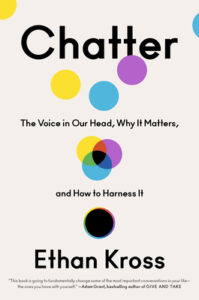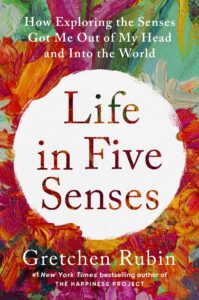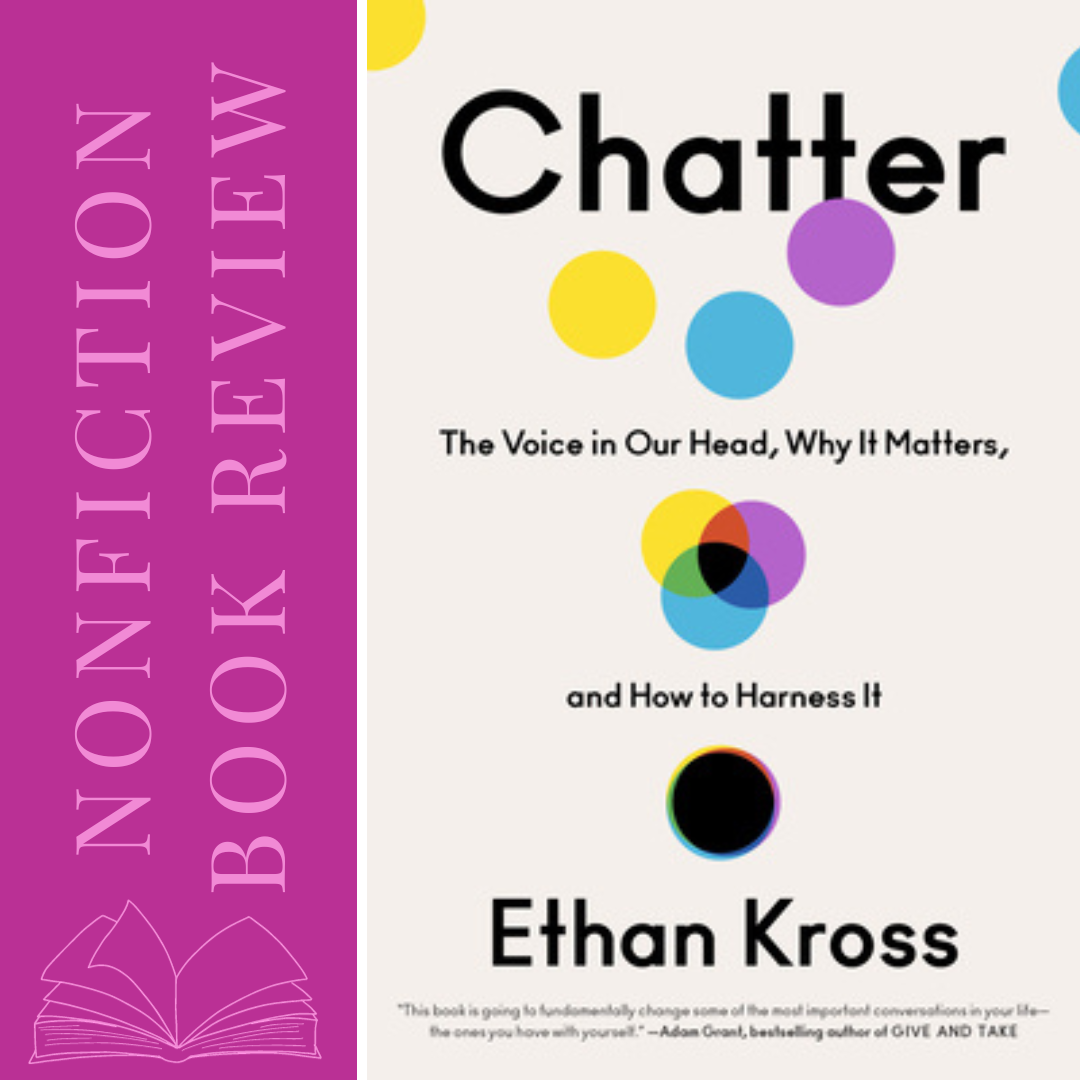I enjoy keeping nonfiction on regular rotation in my reading life. My areas of interest usually have to do with self help or personal development whether that’s positive psychology books, parenting guides, or deep dives into the latest nutrition findings.
The book choices often relate in that they contain something to learn that can improve or better my life. My big picture focus is almost always on living a good life.
Some years I fit in more nonfiction reads than others.
In my current reading life, I find it works to focus on one nonfiction book a month. I try to take a slow and steady approach reading a chapter a day to really absorb the information. Often times that means it takes me around 2 weeks to finish the book. Once the book was so dense it spanned 2 months – Already Enough by Lisa Olivera (4 stars).
To expand on that trend in my reading life, I started a nonfiction book club this year over on Fable called Pearls of Wisdom. It’s a book club for anyone who wants to learn, reflect, and grow together through nonfiction reading.
What is Fable?
Fable is a free app that makes it easy to read with others at your own pace. It breaks a book down by chapters within the online book club.
While it doesn’t matter as much with nonfiction this breakdown allows readers to avoid spoilers. You don’t open a chapter until you’re done reading it. After completing a chapter you can see what other readers thought. Then you can reply to their comments or add your own notes, reactions, and meaningful quotes to the chat.
I always have my current book club selections posted on the blog’s homepage if you’re interested in reading together!
This app is also my favorite way to buddy read.
Why a Nonfiction Review Section?
While I enjoy my fable book clubs, I miss the process of sharing an in-depth review of my nonfiction read on the blog.
I used to do this nonfiction spotlight for my year of health experiment way back in 2021 when I was pregnant with Mr. O.
Writing out my thoughts, feelings, and takeaways from the book helps me work through them. It also solidifies them in my mind to take forward with me.
I find I’m more comfortable being a little bit more vulnerable in this space. That vulnerability is where those nuggets of wisdom from the reading life can move forward into actual life.
October’s Nonfiction Read
In October we read Chatter: The Voice in Our Head, Why It Matter, and How to Harness It by Ethan Kross.
In this book, Kross discussed the effects of the voice inside our heads, which he defined as “chatter”, the dangers when it’s negative, and tools to have it help you rather than harm.
As someone both curious about the inner voice that we all have and someone who struggles with her own inner critic, I wanted to learn more about self talk. I was also eager to uncover strategies for training my inner voice to be more positive, supportive, and encouraging.
It sounded like a great and necessary skill or habit to develop.
Chatter: The Voice in Our Head, Why It Matters, and How to Harness It by Ethan Kross

Book Blurb:
“AN AWARD-WINNING PSYCHOLOGIST REVEALS THE HIDDEN POWER OF OUR INNER VOICE AND SHOWS HOW WE CAN HARNESS IT TO LIVE A HEALTHIER, MORE SATISFYING, AND MORE PRODUCTIVE LIFE.
Tell a stranger that you talk to yourself, and you’re likely to get written off as eccentric. But the truth is that we all have a voice in our head. When we talk to ourselves, we often hope to tap into our inner coach but find our inner critic instead. When we’re facing a tough task, our inner coach can buoy us up: Focus – you can do this. But, just as often, our inner critic sinks us entirely: I’m going to fail. They’ll all laugh at me. What’s the use?
In ‘CHATTER’, acclaimed psychologist Ethan Kross explores the silent conversations we have with ourselves. Interweaving groundbreaking behavioral and brain research from his own lab with real-world case studies – from a pitcher who forgets how to pitch, to a Harvard undergrad negotiating her double life as a spy – Kross explains how these conversations shape our lives, work, and relationships. He warns that giving in to negative and disorienting self-talk – what he calls “chatter” – can tank our health, sink our moods, strain our social connections, and cause us to fold under pressure.
But the good news is that we’re already equipped with the tools we need to make our inner voice work in our favor. These tools are often hidden in plain sight – in the words we use to think about ourselves, the technologies we embrace, the diaries we keep in our drawers, the conversations we have with our loved ones, and the cultures we create in our schools and workplaces.
Brilliantly argued, expertly researched, and filled with compelling stories, ‘CHATTER’ gives us the power to change the most important conversation we have each day: the one we have with ourselves.”
Gems from the Introduction
I want to share a few quotes I loved from the introduction. These may give you an idea of whether this book is for you.
“Chatter consists of the cyclical negative thoughts and emotions that turn our singular capacity for introspection into a curse rather than a blessing. It puts our performance, decision making, relationships, happiness, and health in jeopardy. We think about that screwup at work or misunderstanding with a loved one and end up flooded by how bad we feel. Then we think about it again. And again. We introspect hoping to tap into our inner coach but find our inner critic instead.”
“This inescapable tension of the inner voice as both a helpful superpower and destructive kryptonite that hurts us is what I think of as the great puzzle of the human mind. How can the voice that serves as our best coach also be our worst critic?”
These two findings were fascinating to me!
“We spend one-third to one-half of our waking life not living in the present. As naturally as we breathe, we “decouple” from the here and now, our brains transporting us to past events, imagined scenarios, and other internal musings. This tendency is so fundamental it has a name: our “default state.” It is the activity our brain automatically reverts to when not otherwise engaged, and often even when we are otherwise engaged.”
“Our verbal stream of thought is so industrious that according to one study we internally talk to ourselves at a rate equivalent to speaking four thousand words per minute out loud.”
There is hope! This book shares how to do it – how to tame that inner voice.
“One of the most crucial insights I’ve had during my career is that the instruments necessary for reducing chatter and harnessing our inner voice aren’t something we need to go looking for. They are often hidden in plain sight, waiting for us to put them to work. They are present in our mental habits, quirky behaviors, and daily routines, as well as in the people, organizations, and environments we interact with. In this book, I will lay bare these tools and explain not only how they work but how they fit together to form a toolbox that evolution crafted to help us manage the conversations we have with ourselves.”
“The key to beating chatter isn’t to stop talking to yourself. The challenge is to figure out how to do so more effectively.”
Review of Chatter by Ethan Kross
I gave this book 5 stars!
I found it easy to read, conversational, and backed with a lot of studies and research notes. There was a great balance of science while still being entertaining to read.
There were some messages within this book that really resonated with me. I’ll get into those below in my pearls of wisdom takeaways.
The main point of this book was how the common advice to “go inside” is wrong for many people when it comes to dealing with their inner voice. It often causes them to fixate and spiral even more. Any method that allows distance or “looking outward” from your problem (of which Kross offers many tangible solutions) is actually more helpful.
I found the information about social co-rumination and how it affects our relationships fascinating!
“While this sounds normal and harmless, repeatedly sharing our negative inner voice with others produces one of the great ironies of chatter and social life: We voice the thoughts in our minds to the sympathetic listeners we know in search of their support, but doing so excessively ends up pushing away the people we need most. It’s as though the pain of chatter makes people less sensitive to the normal social cues that tell us when enough is enough. To be clear, this doesn’t mean that talking to others about your problems is harmful per se. But it highlights how chatter can transform an otherwise helpful experience into something negative.”
As well as the ways talking, venting, or sharing our problems with others can go wrong. I enjoyed learning the reasons behind why this is.
“Here’s how talking goes wrong. To demonstrate that they are there to offer emotional support, people are usually motivated to find out exactly what happened to upset us—the who-what-when-where-why of the problem. They ask us to relate what we felt and tell them in detail what occurred. And though they may nod and communicate empathy when we narrate what happened, this commonly results in leading us to relive the very feelings and experiences that have driven us to seek out support in the first place, a phenomenon called co-rumination. Co-rumination is the crucial juncture where support subtly becomes egging on. People who care about us prompt us to talk more about our negative experience, which leads us to become more upset, which then leads them to ask still more questions. A vicious cycle ensues, one that is all too easy to get sucked into, especially because it is driven by good intentions.”
“Harmful co-ruminative dynamics emerge out of otherwise healthy, supportive relationships because our emotional, inner-voice mechanics aren’t actually like a hydraulic system, as Freud and Aristotle and conventional wisdom suggest. Letting out steam doesn’t relieve the pressure buildup inside.”
I appreciated the breakdown on how to alter this pattern so we can support others better and seek better support for ourselves.
“The most effective verbal exchanges are those that integrate both the social and the cognitive needs of the person seeking support. The interlocutor ideally acknowledges the person’s feelings and reflections, but then helps her put the situation in perspective. The advantage of such approaches is that you’re able to make people who are upset feel validated and connected, yet you can then pivot to providing them with the kind of big-picture advice that you, as someone who is not immersed in their chatter, are uniquely equipped to provide. Indeed, the latter task is critical for helping people harness their inner voice in ways that lead them to experience less chatter over time.”
Chapter 6, titled Outside In, reminded me of The Nature Fix, a book I read a couple years ago during the year of health experiment. The books share a lot of the same studies and findings about how our environment affects us. In this case how it can calm us and help us gain distance and perspective.
Lastly the tool kit breakdown with a short review of each method at the end of the book is an amazing resource! Some of the tools are already helping me and I look forward to reflecting and implementing more.
Pearls of Wisdom Takeaways
- My biggest takeaway was that the inner voice isn’t something to despise. It’s evolutionary which means it’s there for a reason. It can be something to embrace. We have the power to use it for good instead of letting the negative chatter take over.
- In a culture that screams to live in the moment, get out of your head, and be more present, it was refreshing to hear that it’s normal and ok to have a rich interior life. That was something that I personally really needed to hear. It allowed me to shift my mindset – making room for more thinking, processing, and reflecting. And that doing so isn’t time wasted or something to feel guilty about.
- I tried switching to using you or even my name while journaling and it was really helpful for distancing myself and gaining perspective.
- I want to be more aware of when a social interaction is spiraling into co-rumination and be sure I’m doing my part to support someone’s social AND cognitive needs.
- The ideas on how story narrative is tied into how we make sense of the world sent me on a deep dive into this topic. I’m now looking for a book that explores the science behind stories from a human history or psychology stand point rather than an author one.
“Our verbal stream plays an indispensable role in the creation of our selves. The brain constructs meaningful narratives through autobiographical reasoning. In other words, we use our minds to write the story of our lives, with us as the main character. Doing so helps us mature, figure out our values and desires, and weather change and adversity by keeping us rooted in a continuous identity. Language is integral to this process because it smooths the jagged and seemingly unconnected fragments of daily life into a cohesive through line. It helps us “storify” life.
- I was really surprised by the revelation that not all talking is good and how that translates to therapy. This insight even came up in a random conversation with my mom. I feel like the information about taking care when choosing a therapist and asking what forms of talk therapy they use is very important.
“The first thing to keep in mind is that there are countless forms of talk therapy and they often differ drastically in approach. Many empirically validated forms of therapy such as cognitive behavioral therapy employ precisely the kinds of techniques we’ve been talking about throughout this chapter; they provide clients with emotional support while also crucially helping them engage in cognitive problem solving.”
“The take-home point is that if you find yourself needing more than a conversation with a friend or loved one to deal with your chatter, given what you now know, have a conversation with your prospective mental-health providers to learn about their approach and find out whether it is empirically supported.”
November’s Nonfiction Read

In November we’re reading Life in Five Senses: How Exploring the Senses Got Me Out of My Head and Into the World by Gretchen Rubin.
Gretchen Rubin is one of my favorite positive psychology authors! I’ve read most of her books – it all started with The Happiness Project for me – and I identify as a questioner thanks to her four tendencies framework.
With the holidays approaching, November seems like a fantastic month to learn how embracing all of our senses can make us happier!
Is this struggle with chatter something you can relate to? How do you manage it? What are some of the techniques you find helpful? If you’ve read Chatter by Ethan Kross, I’d love to hear some of your thoughts and takeaways!



2 responses to “Nonfiction Book Review: Chatter by Ethan Kross”
Wow! This was such a thorough review! I definitely struggle with the inner chatter and I’m very curious about the co-rumination and how that works. Like are we doing that to each other with our back and forth together? ??
It’s so interesting right! I think we do have a tendency to spiral into co-rumination when we talk on the phone or with certain topics. Especially those that have no real answer if they’re out of our control. For me I know we have a limited time to communicate or visit so I like to try not to get bogged down in those “negative” spirals unless there’s something new or timely to discuss. FYI: This is strictly any issue or topic I’m bringing to the table lol, I’m not judging your topics!!! Let’s add this to our email conversation if we want to explore it further ❤️